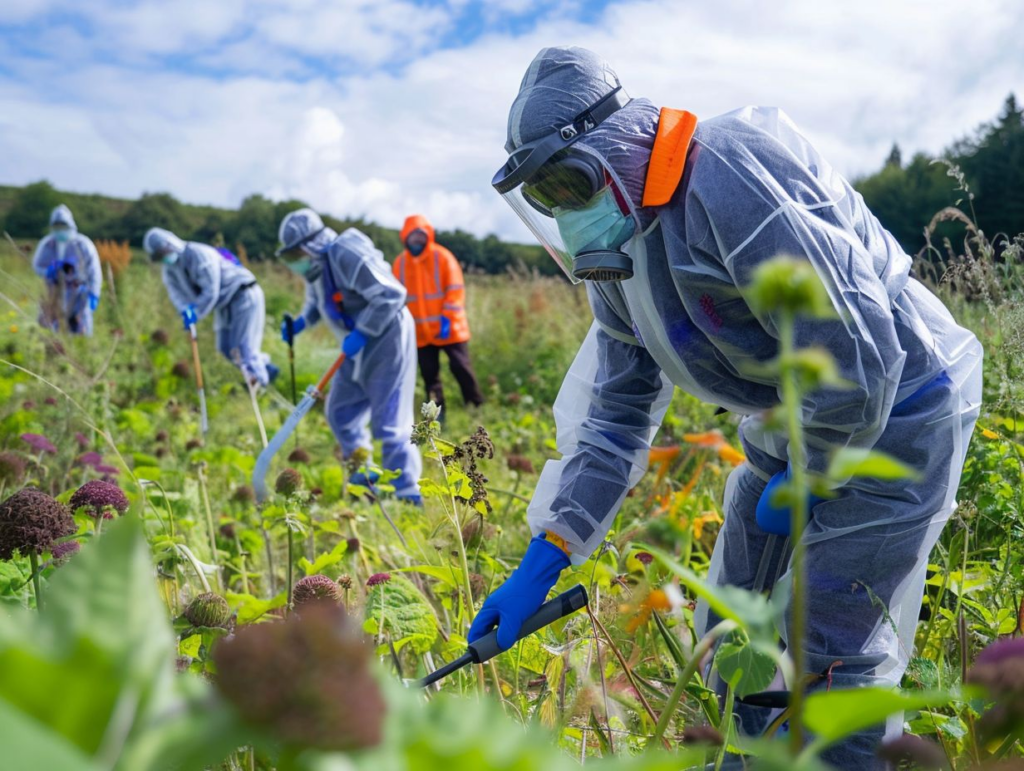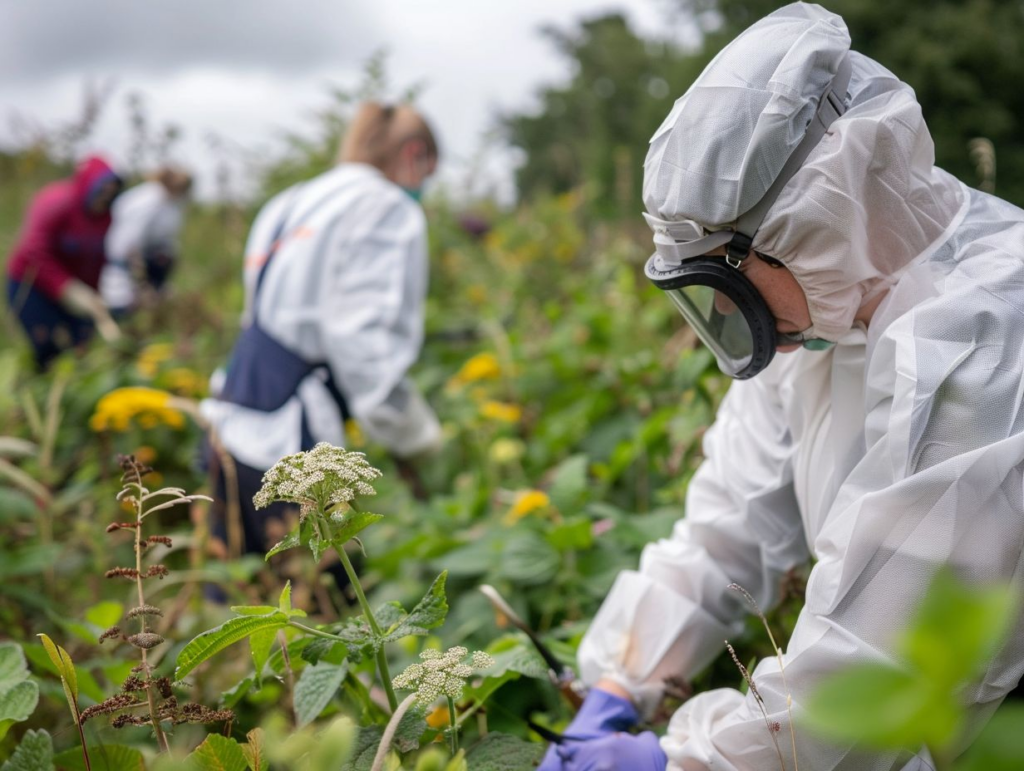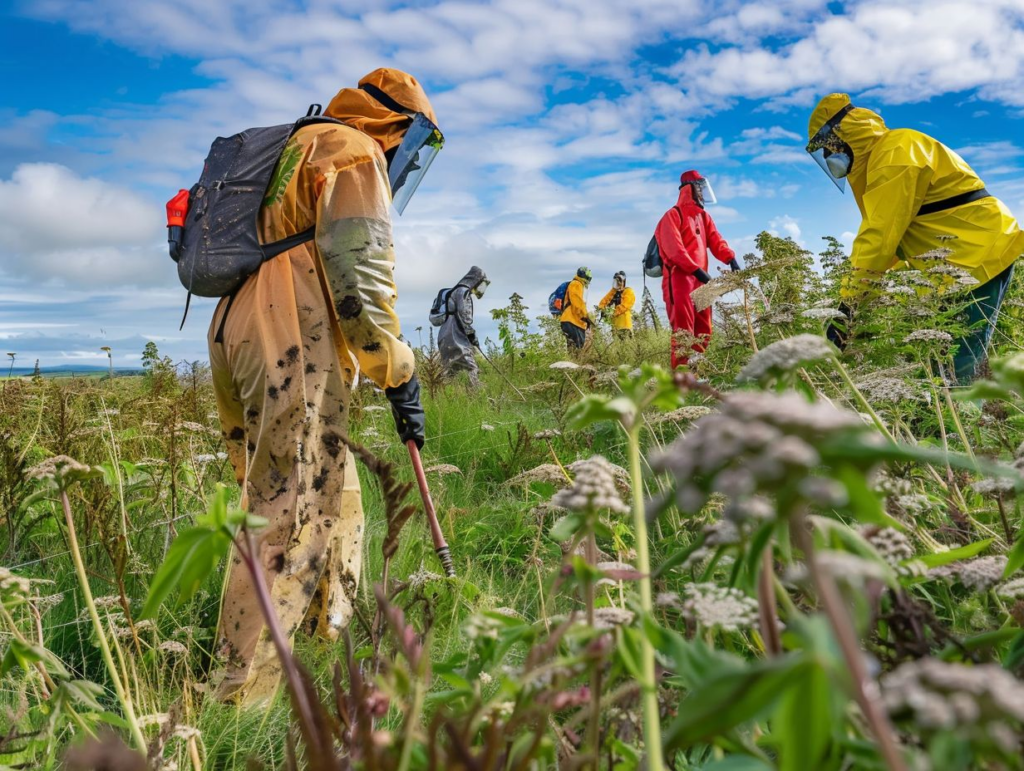Giant Hogweed Removal – How To Get Rid
If you have noticed Giant Hogweed, it is important to be aware of its risks.
We discuss the dangers of Giant Hogweed, how it spreads, and why it is essential to address this invasive plant.
At Japanese Knotweed Removal, we have the expertise and experience to remove Giant Hogweed from your property effectively.
From site assessment to disposal, we have safe and efficient methods to eradicate this harmful plant completely.
Discover the benefits of hiring a professional for Giant Hogweed removal and how we can help you safeguard your property and environment.
What is Giant Hogweed?
Giant hogweed, scientifically known as Heracleum Mantegazzianum, is an invasive plant species spread extensively throughout the UK, causing significant concern among environmentalists and wildlife experts.
It is characterised by its towering height, often reaching over 15 feet, with large umbrella-like white flowers spanning up to 2 feet in diameter.
The plant’s leaves are deeply lobed and have a coarse texture, making it easily distinguishable from other common species.

Originally native to the Caucasus region in Southwest Asia, Giant Hogweed was introduced to the UK in the 19th century for ornamental purposes due to its impressive size and appearance.
Its aggressive nature and rapid growth rate have made it a harmful invasive species.
Why is Giant Hogweed a Problem in the UK?
Giant Hogweed poses a severe threat to the UK’s environment and biodiversity, disrupting native vegetation and contributing to soil erosion along riverbanks and other habitats.
What Are the Risks of Giant Hogweed?
The sap of Giant Hogweed is highly toxic and can cause severe skin reactions and long-term health hazards, making it crucial to understand the risks associated with this invasive species.
Exposure to the sap of Giant Hogweed can lead to phytophotodermatitis, a skin condition that results in painful burns, blisters, and in severe cases, permanent scarring.
These skin reactions are aggravated when the affected area is exposed to sunlight, leading to heightened discomfort and a risk of infection.
Not only does Giant Hogweed threaten individual health, but its presence can also have legal implications for landowners, as it is regulated under the Wildlife and Countryside Act, 1981.
Landowners may be required to control or eradicate this plant to prevent its spread and protect public health.
How Does Giant Hogweed Spread?
Giant Hogweed spreads rapidly through its prolific seed production.
Each plant can release thousands of seeds that can be dispersed by wind, water, and soil movement.
When these seeds land near riverbanks, they find an ideal environment for germination and growth. Riverbanks offer moist soils and ample sunlight, creating a perfect ecosystem for Giant Hogweed to thrive.
As the plant matures, it further contributes to seed dispersal, with seeds easily carried downstream by the flowing water. The seeds can also get buried in the soil, forming a seed bank that ensures a continuous supply for future growth.
This persistent seed bank poses a significant challenge for long-term management strategies, requiring targeted interventions to prevent the spread of this invasive species.
How Can We Help with Giant Hogweed Removal?
We specialise in the professional removal and control of Giant Hogweed in the UK, offering safe and effective solutions to manage this invasive species and protect your property and environment.

Our Expertise in Invasive Plant Removal
Our team of specialists at Japanese Knotweed Removal is highly experienced in dealing with invasive plant species, including Giant Hogweed, ensuring comprehensive and professional removal services across the UK.
With years of expertise in the field, our team members deeply understand the biology and behaviour of various invasive plants.
They are equipped with the latest techniques and equipment to efficiently tackle many species, such as Japanese Knotweed, Himalayan Balsam, and Bamboo.
Each team member undergoes rigorous training to stay updated with the best practices in invasive plant removal. This ensures that we deliver effective solutions tailored to our clients’ specific needs.
Our Safe and Effective Methods
We employ a combination of safe and effective methods for treating and preventing Giant Hogweed, including non-chemical and chemical control techniques tailored to each situation.
Physical removal is often used for smaller infestations of Giant Hogweed, where the plant can be manually uprooted to prevent further spread. This method is labour-intensive but can be highly effective in controlling the plant’s growth.
- Herbicide application (glyphosate) is a common chemical control method for larger infestations. Glyphosate-based herbicides selectively target the Giant Hogweed without harming surrounding vegetation when applied correctly.
- Non-chemical alternatives, such as mulching or covering the affected area with plastic to deprive the plant of sunlight, are also considered in our treatment plans.
Considering safety and environmental impact is paramount in our approach, ensuring that the methods used are not only effective but also sustainable and eco-friendly.
Our Experience in Dealing with Giant Hogweed
With years of experience in managing and eradicating Giant Hogweed, our specialists have developed effective strategies to tackle infestations and prevent re-growth.
Our team’s expertise extends across various projects where Giant Hogweed removal was successfully executed, leaving behind areas free from this invasive species.
By utilising a combination of cutting-edge techniques and eco-friendly practices, they ensure that the eradication process is thorough and long-lasting. Long-term management strategies are a key focus, aiming to prevent any chance of re-infestation.
This proactive approach not only clears existing infestations but also establishes a sustainable environment that hinders the regrowth of Giant Hogweed plants.
What is the Process for Giant Hogweed Removal?
The process for Giant Hogweed eradication is meticulously planned and executed to ensure safety and environmental sustainability, commencing with a thorough site assessment and survey of the infested area.
Site Assessment and Survey
Our specialists conduct a thorough site assessment and survey to accurately identify the extent of the Giant Hogweed infestation and plan the appropriate control measures.

The team carefully examines the plant morphology, paying close attention to its distinctive features such as its height, stem colour, leaf shape, and flower characteristics to confirm the presence of Giant Hogweed.
They create detailed maps of the infested areas, marking the locations and extent of the infestation for precise treatment planning.
The specialists evaluate the growth stage of the plants, determining whether they are in the early, mid, or late growth stages to tailor the treatment methods accordingly.
Treatment Plan and Options
Based on the site assessment, we develop a customised treatment plan that includes a range of control options, from chemical treatments with herbicides like glyphosate to non-chemical control methods.
Factors such as the severity of the infestation, type of vegetation, and the proximity to water bodies play a crucial role in determining the most effective treatment approach.
Environmental conditions, including weather patterns and soil composition, also impact the choice of treatment.
When crafting a treatment plan, we carefully assess these variables to ensure that the chosen method achieves optimal results without causing harm to the surrounding ecosystem.
Some of the treatment options we may consider include targeted spot applications, mechanical removal, biological controls using natural predators, or even long-term monitoring and prevention strategies.
Each method comes with its own set of advantages and limitations, guiding us in making an informed decision that aligns with the specific requirements of the site.
Removal and Disposal of Giant Hogweed
The removal and disposal of Giant Hogweed are carried out with utmost care to ensure safety and compliance with legal regulations, following a systematic and thorough process.
Physical removal of Giant Hogweed typically involves wearing protective clothing, such as gloves and goggles, to prevent skin contact with its sap, which can cause severe burns and blisters.
Once removed, the plant is carefully bagged and sealed to prevent any further spread of its seeds. It is then safely disposed of in designated landfill sites or through incineration to ensure complete eradication.
Improper disposal of Giant Hogweed can have serious legal implications, as it is classified as a noxious weed in many regions. Therefore, following the correct removal and disposal procedures is essential to avoid fines and penalties.
By adhering to relevant legislation, such as environmental protection laws, the removal process not only ensures the safety of individuals but also protects the ecosystem from the harmful effects of this invasive plant.”
What Are the Benefits of Hiring a Professional for Giant Hogweed Removal?
Hiring a professional for Giant Hogweed removal offers numerous benefits, including ensuring safety and compliance with legal requirements, effectively preventing re-growth, and saving time and effort for property owners.

Ensuring Safety and Compliance
Professional removal of Giant Hogweed ensures safety and compliance with legal regulations, protecting both people and the environment from the plant’s toxic effects and potential legal implications.
Professionals trained in handling Giant Hogweed follow strict safety protocols to prevent direct contact with its toxic sap, which can cause severe skin irritation and even blindness if it gets into the eyes.
Compliance with laws such as the Wildlife and Countryside Act, 1981, is crucial to ensure the proper disposal of this invasive species without causing harm to the ecosystem.
Attempts at DIY removal without proper knowledge and equipment may expose individuals to significant health risks and inadvertently spread the plant further, ultimately exacerbating the problem.
Preventing Re-growth and Spreading
Preventing the re-growth and spreading of Giant Hogweed is a key benefit of hiring specialists, who implement effective control methods and strategies to address the seed bank and long-term management.
Professionals often employ a combination of proactive measures to ensure that Giant Hogweed does not re-emerge in treated areas. One crucial method is regular monitoring to detect any potential regrowth early on. By staying vigilant, experts can promptly address any new growth before it becomes a larger issue.
Follow-up treatments play a vital role in preventing the re-establishment of this invasive plant species. These treatments help eradicate any remaining plants or seeds that may have survived initial control efforts.
Saving Time and Effort
Hiring professionals to remove Giant Hogweed saves significant time and effort, as they have the expertise, tools, and processes to handle the infestation efficiently and effectively.
Professional services streamline the removal process by performing a thorough assessment of the infestation, identifying the extent of the problem and developing a strategic plan for eradication. By utilising specialised equipment and proven techniques, professionals can efficiently remove the Giant Hogweed without risking its spread or regrowth.
This level of expertise ensures that the removal is not only quick but also thorough, minimising the chances of a resurgence. Professional services take care of the disposal in a safe and environmentally friendly manner, adhering to regulations and guidelines to protect both the property and surrounding ecosystem.
Frequently Asked Questions
What is Giant Hogweed Removal?
Giant Hogweed Removal is the process of safely and effectively removing the invasive plant species known as Giant Hogweed from an area. This plant can be extremely harmful to human health and the environment, making removal an important task.
Why should I hire a professional for Giant Hogweed Removal?
Giant Hogweed can be difficult to remove completely and safely, as it can grow in hard-to-reach areas and its sap can cause severe skin irritation. Hiring a professional removal company, like Japanese Knotweed Removal, ensures that the plant is removed completely and safely, minimising the risk of harm.
What services does Japanese Knotweed Removal offer for Giant Hogweed Removal?
At Japanese Knotweed Removal, we offer a comprehensive Giant Hogweed Removal service that includes site surveys, risk assessments, and removal methods tailored to your specific situation. We also offer ongoing monitoring and maintenance to prevent regrowth.
How long does Giant Hogweed Removal take?
The duration of Giant Hogweed Removal depends on the size and severity of the infestation. In most cases, it can take several treatments over the course of a few months to completely eradicate the plant. Our team will assess your situation and provide a timeline for removal.
Is Giant Hogweed Removal safe for the environment?
At Japanese Knotweed Removal, we use safe and environmentally friendly methods for Giant Hogweed Removal. We prioritize the protection of the surrounding ecosystem and will dispose of the plant safely and responsibly.
What areas do you offer Giant Hogweed Removal services in?
As a company based in the UK, we offer Giant Hogweed Removal services throughout the UK. Our team has extensive knowledge and experience in identifying and removing this invasive plant species, making us the go-to experts for Giant Hogweed Removal in the UK.
Areas We Cover
- Giant Hogweed Removal Greater London
- Giant Hogweed Removal Essex
- Giant Hogweed Removal Hertfordshire
- Giant Hogweed Removal Kent
- Giant Hogweed Removal Surrey
- Giant Hogweed Removal Bedfordshire
- Giant Hogweed Removal Buckinghamshire
- Giant Hogweed Removal Berkshire
- Giant Hogweed Removal Cambridgeshire
- Giant Hogweed Removal East Sussex
- Giant Hogweed Removal Hampshire
- Giant Hogweed Removal West Sussex
- Giant Hogweed Removal Suffolk
- Giant Hogweed Removal Oxfordshire
- Giant Hogweed Removal Northamptonshire
- Giant Hogweed Removal Wiltshire
- Giant Hogweed Removal Warwickshire
- Giant Hogweed Removal Norfolk
- Giant Hogweed Removal Leicestershire
- Giant Hogweed Removal Dorset
- Giant Hogweed Removal Gloucestershire
- Giant Hogweed Removal West Midlands
- Giant Hogweed Removal Somerset
- Giant Hogweed Removal Worcestershire
- Giant Hogweed Removal Nottinghamshire
- Giant Hogweed Removal Bristol
- Giant Hogweed Removal Derbyshire
- Giant Hogweed Removal Lincolnshire
- Giant Hogweed Removal Herefordshire
- Giant Hogweed Removal Staffordshire
- Giant Hogweed Removal Cardiff
- Giant Hogweed Removal South Yorkshire
- Giant Hogweed Removal Shropshire
- Giant Hogweed Removal Greater Manchester
- Giant Hogweed Removal Cheshire
- Giant Hogweed Removal West Yorkshire
- Giant Hogweed Removal Swansea
- Giant Hogweed Removal North Yorkshire
- Giant Hogweed Removal East Riding of Yorkshire
- Giant Hogweed Removal Merseyside
- Giant Hogweed Removal Devon
- Giant Hogweed Removal Lancashire
- Giant Hogweed Removal Durham
- Giant Hogweed Removal Tyne and Wear
- Giant Hogweed Removal Northumberland
- Giant Hogweed Removal Cumbria
- Giant Hogweed Removal Edinburgh
- Giant Hogweed Removal Glasgow
